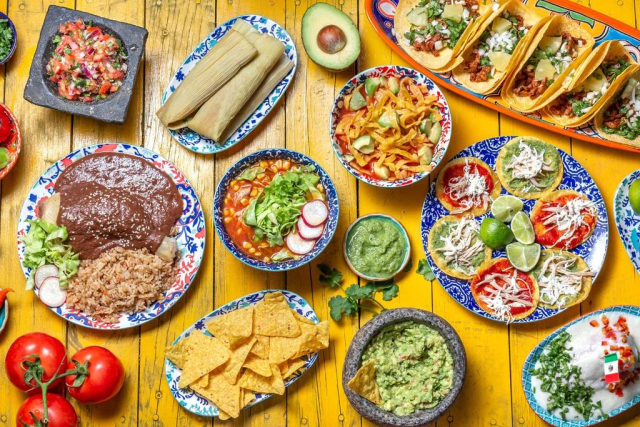Mexican gastronomy is a vast universe of flavors, colors and aromas that reflect the rich cultural diversity of Mexico . Each dish is a living testimony of centuries of history and fusion of cultures, from ancient pre-Hispanic traditions to contemporary influences that enrich the Mexican table. In this space, you will learn about its emblematic ingredients that reveal the passion that Mexicans put into each recipe . From the exuberant markets to the most remote corners of the country, Mexican gastronomy is a sensory journey that immerses us in a unique experience.
Mexico's culinary diversity deserves recognition; it is a place where tradition and innovation converge to delight palates and tell stories that transcend borders. Discover the authentic flavors and stories behind the most emblematic dishes of Mexican cuisine.
Typical Mexican dishes in Cancun
-
Ceviche: prepared with fresh fish marinated in lemon with onion, tomato, cilantro and chili. They are fresh white fish fillets such as grouper, croaker or snapper, although shellfish such as shrimp, octopus or squid can also be used. The most characteristic of this preparation is the process of "cooking" the fish in lemon or lime juice, which makes it acquire a firm and opaque texture, which is known as "cold cooking." This process not only changes the texture of the fish but also enhances its flavor and makes it safe for consumption.
The marinated fish is combined with fresh ingredients such as finely chopped red onion, tomato, cilantro and serrano or jalapeño chile, which give it an explosion of flavors and textures. It is often seasoned with salt and pepper, and sometimes other ingredients such as avocado, cucumber or mango are added, depending on the chef's preference or the region.
Ceviche is commonly served as an appetizer or entrée, accompanied by tortilla chips (corn chips), toast, or crackers. It is a refreshing and light option, perfect to enjoy on hot days by the sea. -
Tacos al pastor: strips of pork marinated with achiote and spices, roasted on a top and served in corn tortillas with onion, pineapple and cilantro. Originating from Mexican cuisine, these tacos are a fusion of flavors that capture the very essence of the country's culinary tradition. They are prepared with thin slices of pork marinated in a mixture of annatto, chilies, spices and citrus juices , which gives them their characteristic red color and deep, smoky flavor. The meat is stacked on a vertical top and roasted slowly, allowing the juices and aromas to concentrate, creating layers of intense, juicy flavors. When served, thin slices of meat are cut directly from the trompo and placed on freshly made corn tortillas, accompanied by pieces of roasted pineapple, onion, cilantro and a variety of sauces that add a spicy and vibrant touch. Tacos al pastor are a culinary experience that transcends the ordinary, inviting diners to immerse themselves in a feast of flavors, textures and aromas that capture the very essence of Mexico.
-
Pozole: traditional soup made with hominy corn and pork or chicken, accompanied by lettuce, radishes, onion and lemon. This comforting soup has its roots in pre-Hispanic culture and has evolved over the centuries to become a must-have culinary delight. Its base is hominy corn, which is slowly cooked until it reaches a tender texture and combined with pork or chicken, creating a rich and flavorful broth. However, what sets pozole apart is its distinctive flavor, which comes from a combination of chiles, spices, and herbs, such as guajillo chile, oregano, and garlic, which are used to season and add depth to the broth. When served, it is accompanied with a variety of fresh and crisp ingredients, such as lettuce, radishes, onion and lemon , which add an explosion of colors and textures.
-
Sopes: Thick corn tortillas with raised edges, topped with beans, meat, cheese, cream, and salsa. Sope is a traditional delicacy found throughout Cancun and Mexico. This dish consists of a thick, round corn tortilla with raised edges , which is cooked on a comal until lightly browned. What is distinctive about sope is its versatility, since it can be served as an appetizer, a main dish or even as a dessert, depending on the ingredients with which it is filled . It is usually topped with a layer of refried beans, followed by carne asada, shredded chicken, chorizo or vegetables, and crema, crumbled queso fresco, hot sauce, and fresh cilantro . The combination of the crunchy corn base with the succulent and flavorful ingredients makes it an irresistible delight that satisfies all the senses.
-
Elotes and esquites: Corn cobs cooked and covered with mayonnaise, grated cheese, chili powder and lemon juice, or cooked shelled corn served in a glass with the same condiments.
-
Tamales: corn dough filled with meat, chicken or vegetables, wrapped in corn husks and steamed. These delicacies consist of a soft and aromatic corn dough, seasoned with butter or oil and filled with a variety of ingredients that can include meat, chicken, pork, chilies, cheese, beans, or even fruits such as pineapple or raisins, all wrapped in corn husks and steamed. Their origin dates back to pre-Hispanic times and, since then, they have been a fundamental element in festivities and celebrations, as well as a popular option for breakfast or as a snack.
-
Enchiladas: corn tortillas filled with chicken, meat or cheese, bathed in chili sauce and accompanied by cream and fresh cheese. These tasty creations are typically served with cream, grated cheese, chopped onion, and fresh cilantro, adding an explosion of flavors and textures to every bite. Enchiladas are a versatile dish that embody the very essence of Mexican cuisine, with their combination of simple yet delicious ingredients and their ability to satisfy the most demanding cravings with their perfect blend of spicy, sweet and creamy.
-
Chilaquiles: pieces of tortilla fried and then cooked in red or green sauce, served with cream, cheese and onion. This comforting dish consists of pieces of corn tortilla fried and then cooked in red or green sauce, until they soften slightly, but retain their crunchy texture. They are typically served with cream, crumbled fresh cheese, chopped onion, cilantro, and sometimes egg or shredded chicken, adding a variety of flavors and textures to each bite. Chilaquiles are a delicacy enjoyed for breakfast or lunch.
-
Mole: Thick, complex sauce made with chili peppers, spices, chocolate and other ingredients, served over chicken or meat. This thick, aromatic sauce is made with a combination of dried chiles, spices, fruits, nuts, chocolate and other ingredients, which are roasted, ground and slowly cooked until a sublime blend of sweet, spicy and earthy is achieved. Mole is prized for its deep flavor and silky texture, and is commonly served over chicken or turkey, accompanied by rice and warm tortillas.
-
Tostadas: Crispy fried corn tortillas, topped with beans, meat, lettuce, cream, cheese and salsa.
-
Cochinita Pibil: pork marinated in annatto and orange juice, wrapped in banana leaves and slowly cooked in an underground oven.
-
Panuchos: corn tortillas filled with beans and then fried, topped with meat, lettuce, avocado, onion and salsa.
-
Chiles Rellenos: poblano chiles stuffed with cheese, meat or beans, breaded and fried, bathed in tomato sauce.
-
Cochinita Cake: sandwich made with bolillo bread filled with cochinita pibil, pickled onion and avocado.
-
Fish or Shrimp Tacos: Breaded and fried fish or shrimp fillets, served on corn tortillas with cabbage, salsa and cream.
Trying Mexican cuisine in Cancun is an experience that goes beyond simply satisfying your appetite; is to delight in a feast of flavors, aromas and traditions that capture the very essence of Mexico. In Cancun, Mexican cuisine is mixed with Caribbean influences, creating a unique fusion that delights the most demanding palates. From vibrant markets to luxury restaurants, every bite tells a story of centuries of history and cultural diversity, offering an endless variety of dishes ranging from classic tacos al pastor to exquisite ceviches and comforting tamales.
We invite you to take a look at other articles at: https://yate.co/es/blog


